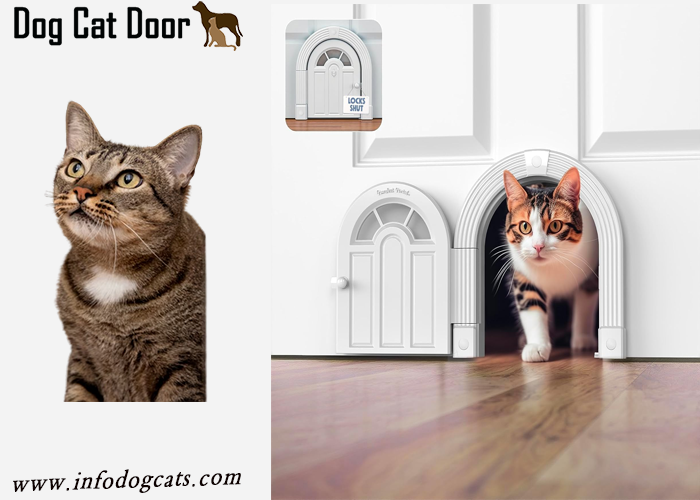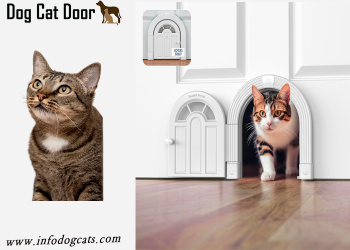Learn more about Best Cat Door for Interior Doors 2024; the best cat door for interior doors with our comprehensive guide. We delve into the pros and cons, provide essential tips, and highlight top recommendations to help you choose the perfect cat door for your home.
Why a Cat Door for Interior Doors is a Game-Changer
When it comes to making your feline friend’s life more comfortable, installing a cat door for interior doors is a game-changer. Imagine a world where your cat can seamlessly move between rooms without you having to get up constantly. Sounds like a dream, right? Whether you’re dealing with a feisty kitten or a seasoned senior, a cat door can offer convenience and independence for your pet. In this guide, we’ll explore everything you need to know about choosing the best cat door for interior doors, weighing the pros and cons, and finding the perfect match for your home.
Why Consider a Cat Door for Interior Doors?
You might be wondering, “Why do I need a cat door for interior doors?” Well, the answer is simple yet impactful. A cat door offers your pet freedom and flexibility, allowing them to navigate your home without restrictions. This can be especially useful if you have multiple rooms or if you’re trying to manage your cat’s access to certain areas, like a litter box or a designated sleeping zone. By investing in a cat door, you’re essentially giving your feline friend the gift of autonomy.
Choosing the Right Cat Door: Factors to Consider
Selecting the ideal cat door for your interior door involves more than just picking a design you like. It’s crucial to consider several factors to ensure it meets both your needs and your cat’s preferences. First, think about the size of the door. It should be large enough to accommodate your cat comfortably but not so big that it looks out of place. Additionally, consider the material and durability. You want a door that can withstand frequent use and the occasional roughhousing.
Types of Cat Doors for Interior Doors
There are several types of cat doors available, each with its unique features and benefits. Here are a few popular options:
- Flap Cat Doors: These are the most common type and come with a flexible flap that swings open when your cat pushes against it. They are easy to install and perfect for standard interior doors.
- Tunnel Cat Doors: These doors have a tunnel-like structure that allows your cat to pass through, providing a bit more privacy. They’re ideal for thicker doors or walls.
- Magnetic Cat Doors: For a more secure option, magnetic cat doors use magnets to keep the flap in place when not in use. This can help keep unwanted drafts out and ensures that only your cat can enter.
- Electronic Cat Doors: The most advanced option, electronic cat doors, use a sensor to allow access only to your cat. This prevents other animals from using the door and can be programmed to open only at certain times.
Pros of Installing a Cat Door for Interior Doors
Installing a cat door can significantly enhance both your and your cat’s quality of life. Here are some of the main advantages:
- Independence for Your Cat: With a cat door, your pet can freely move around without needing your assistance. This means fewer disruptions for you and more freedom for your feline friend.
- Reduced Stress: Allowing your cat to access different parts of the house on their own can reduce stress and anxiety, especially if they feel confined or restricted.
- Convenience: Imagine not having to get up to let your cat in or out of a room. A cat door can save you time and effort, making your daily routine a bit smoother.
Cons of Installing a Cat Door for Interior Doors
While there are many benefits to installing a cat door, there are also some potential downsides to consider:
- Security Concerns: Depending on the type of cat door you choose, there might be concerns about other pets or even intruders gaining access. Electronic cat doors can mitigate this issue but may be more expensive.
- Aesthetic Impact: Some people worry that a cat door might not blend well with their home’s decor. It’s essential to choose a design that complements your interior style.
- Installation Challenges: Installing a cat door, especially one that involves cutting into the door or wall, can be challenging if you’re not handy with tools.
How to Install a Cat Door for Interior Doors
Installing a cat door might seem daunting, but with the right tools and instructions, it’s a manageable DIY project. Here’s a general overview of the process:
- Measure and Mark: Start by measuring the size of the cat door and marking the area on the door where you’ll be installing it. Ensure it’s at an appropriate height for your cat.
- Cut the Opening: Use a jigsaw to carefully cut out the marked area. Make sure to follow the manufacturer’s instructions for precise measurements.
- Install the Door: Place the cat door into the cut-out space and secure it using screws or adhesive, depending on the model.
- Test the Door: Once installed, test the door to ensure it opens and closes smoothly. Make any necessary adjustments to ensure it functions properly.
Maintaining Your Cat Door
To ensure your cat door remains in good working condition, regular maintenance is key. Clean the door periodically to remove any fur, dust, or debris. Check for any signs of wear and tear, and make necessary repairs to keep the door functioning smoothly. If you have a flap-style door, ensure that the flap remains flexible and seals properly to keep out drafts.
Top Recommendations for Cat Doors for Interior Doors
When it comes to choosing a cat door, several models stand out for their quality and functionality. Here are a few top recommendations:
- PetSafe Interior Cat Door: Known for its durability and ease of installation, this model features a simple flap design that works well for most interiors.
- Cat Mate Microchip Cat Door: Ideal for households with multiple pets, this electronic door uses microchip technology to grant access only to your cat.
- SureFlap Microchip Cat Door: Another excellent choice for those looking for an electronic option, this door is known for its reliability and advanced features.
- PlexiDor Performance Cat Door: With its rugged construction and weather-resistant design, this door is perfect for those looking for a durable and long-lasting option.
Choosing the best cat door for your interior doors can greatly enhance your pet’s comfort and independence while making your life a bit easier. By considering the different types available, weighing the pros and cons, and selecting a model that fits your needs, you can find the perfect cat door to suit your home. Remember, a well-chosen cat door can be a small investment with significant rewards for both you and your feline friend.
FAQs
- What size cat door should I choose for my interior door? The cat door should be slightly larger than your cat’s width and height to ensure they can pass through comfortably. Measure your cat before purchasing.
- Can I install a cat door in any type of interior door? Most cat doors can be installed in standardinterior doors, but thicker or non-standard doors might require additional modifications or a specific type of door.
- How do I keep other pets from using the cat door? For added security, consider electronic or magnetic cat doors that restrict access to only your pet.
- Are cat doors noisy? Most cat doors are designed to be quiet. However, flap-style doors might make some noise when in use, especially if not installed correctly.
- How do I clean a cat door? Regularly wipe down the cat door with a damp cloth to remove fur and dirt. For flap-style doors, you might need to remove and clean the flap separately.


